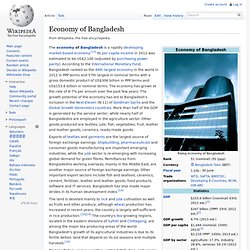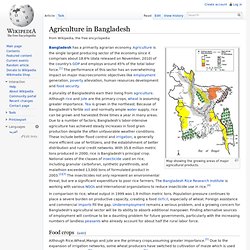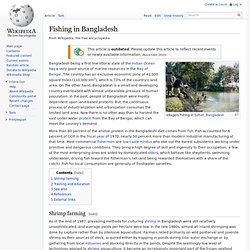

Economy of Bangladesh. Exports of textiles and garments are the largest source of foreign exchange earnings.

Shipbuilding, pharmaceuticals and consumer goods manufacturing are important emerging industries, while the jute sector is re-emerging with increasing global demand for green fibres. Remittances from Bangladeshis working overseas, mainly in the Middle East, are another major source of foreign exchange earnings. Other important export sectors include fish and seafood, ceramics, cement, fertilizer, leather and leather goods, food products, software and IT services. Bangladesh has also made major strides in its human development index.[14] Economy of Bangladesh. Agriculture and Fishing in Bangladesh. Agriculture in Bangladesh.
Map showing the growing areas of major agricultural products.

Bangladesh has a primarily agrarian economy. Agriculture is the single largest producing sector of the economy since it comprises about 18.6% (data released on November, 2010) of the country's GDP and employs around 45% of the total labor force.[1] The performance of this sector has an overwhelming impact on major macroeconomic objectives like employment generation, poverty alleviation, human resources development and food security. A plurality of Bangladeshis earn their living from agriculture. Although rice and jute are the primary crops, wheat is assuming greater importance. Tea is grown in the northeast. In comparison to rice, wheat output in 1999 was 1.9 million metric tons. Food crops[edit] Bangladesh is the fourth largest rice [6] producing country in the world. Wheat is not a traditional crop in Bangladesh, and in the late 1980s little was consumed in rural areas.
Food grains are cultivated primarily for subsistence. Fishing in Bangladesh. Bangladesh being a first line littoral state of the Indian Ocean has a very good source of marine resources in the Bay of Bengal.

The country has an exclusive economic zone of 41,000 square miles (110,000 km2), which is 73% of the country's land area. On the other hand, Bangladesh is a small and developing country overloaded with almost unbearable pressure of human population. In the past, people of Bangladesh were mostly dependent upon land-based proteins. But, the continuous process of industrialization and urbanization consumes the limited land area. Now there is no other way than to harvest the vast under water protein from the Bay of Bengal, which can meet the country's demand. More than 80 percent of the animal protein in the Bangladeshi diet comes from fish. Shrimp farming[edit] As of the end of 1987, prevailing methods for culturing shrimp in Bangladesh were still relatively unsophisticated, and average yields per hectare were low. Training and education[edit] See also[edit] Manufacturing in Bangladesh. Bangladesh textile industry. The Human and clothing (T&C) industries provide the single source of economic growth in Bangladesh's rapidly developing economy.[1] Exports of textiles and garments are the principal source of foreign exchange earnings.

Agriculture for domestic consumption is Bangladesh’s largest employment sector. By 2002 exports of textiles, clothing, and ready-made garments (RMG) accounted for 77% of Bangladesh’s total merchandise exports.[2] By 2013, about 4 million people, mostly women, worked in Bangladesh's $19 billion-a-year industry, export-oriented ready-made garment (RMG) industry. Bangladesh is second only to China, the world's second-largest apparel exporter of western brands. Sixty percent of the export contracts of western brands are with European buyers and about forty percent with American buyers.[3] Only 5% of textile factories are owned by foreign investors, with most of the production being controlled by local investors.[4] Service Industry in Bangladesh. Tourism in Bangladesh. Tourism in Bangladesh is a developing foreign currency earner.

The country was listed by Lonely Planet in 2011 as the "best value destination".[1] In the northern part, comprising the Rajshahi division, there are archaeological sites, including the temple city Puthia in Rajshahi; the largest and most ancient archaeological site, Mahasthangarh in Bogra; the single largest Buddhist monastery, Paharpur in Naogaon; the most ornamental terracota Hindu temple in Bangladesh Kantaji Temple, and many rajbaris or palaces of old zamindars. In the south-western part, mainly the Khulna Division, there is the Sundarbans, the largest mangrove forest of the world with Royal Bengal Tiger and spotted deer.
The historically and architecturally important sixty domed mosque in Bagerhat is a notable site. In the south-eastern part, which is the Chittagong division, there are natural and hilly areas like Chittagong Hill Tracts, along with sandy sea beaches. Economic impact[edit] Chittagong division[edit]